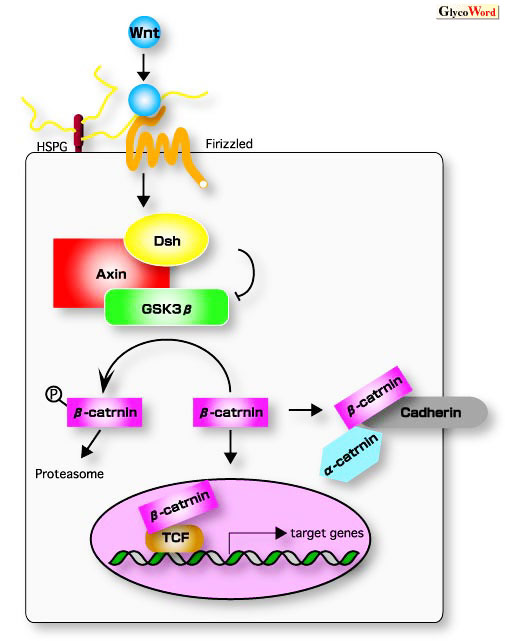| Drosophila Integral-Membrane Proteoglycans | |
|
(Update Issue: March.2, 2007) |
|
|
 |
It has been established that proteoglycans and their associated glycosaminoglycans
play essential roles during the development of a genetically tractable
model organism, Drosophila melanogaster (for reviews, see refs.
1-4). Genetic studies as well as the determination of entire genomic sequences
have revealed that this organism has three integral-membrane heparan sulfate
proteoglycans: a single syndecan gene and two glypican genes, division
abnormally delayed (dally) and dally-like (dly).
As in vertebrates, Drosophila syndecan bears heparan sulfate and is expressed at the cell surface. To date, however, no detailed analysis of the in vivo functions of Drosophila syndecan has been reported.
Dally was identified in a screen for genes affecting cell division patterning
in the Drosophila visual system. dally mutants show defects
in G2-M progression for specific sets of dividing cells in the larval
central nervous system and eye disc. Further genetic studies have demonstrated
that dally is involved in signaling mediated by Decapentaplegic
(Dpp), a Drosophila homologue of the TGF-ß/Bone Morphogenetic
Proteins (BMPs), during the development of eye, antenna, and genitalia.
In the embryonic epidermis, however, dally participates in Wingless
(Wg, a Drosophila member of the Wnt family) signaling but not in
Dpp signaling. dally can therefore differentially affect cellular
responces to Dpp and Wg. These findings are consistent with a role for
Dally as a co-receptor for these growth factors.
Recently, another glypican gene was identified and designated as dally-like (dly). Disruption of the dly function by the RNA interference method suggests that Dly, in addition to Dally, is required for Wg signaling. Overexpression of Dly leads to trapping of extracellular Wg, suggesting that Dly restricts the extracellular diffusion of Wg protein.
Since several mutations in enzymes involved in glycosaminoglycan biosynthesis have been identified in Drosophila, the genetics of this model organism will provide an excellent opportunity to address the proteoglycan functions in developmental processes.
| |
|
 |
|
Fig. The Wnt/Wingless
signaling pathway.
HSPGs act as co-receptors for Wnt/Wingless ligands at the cell surface.
Dsh, Dishevelled; GSK3ß, glycogen synthase kinase 3ß;
TCF, T cell-specific transcription factor. |
|
|
| Hiroshi Nakato (Department of Biology, Tokyo Metropolitan University) | |
|
|
| References | (1) |
Selleck SB: Proteoglycans and pattern formation: sugar biochemistry
meets developmental genetics. Trends Genet 16, 206-212, 2000. |
| (2) |
Lander AD, Selleck SB: The elusive functions of proteoglycans:
in vivo veritas. J Cell Biol. 148,227-232, 2000. |
|
(3) |
Baeg G, Perrimon N: Functional binding of secreted molecules to
heparan sulfate proteoglycans in Drosophila. Curr Opin Cell Biol.
12, 575-580, 2000. |
| (4) |
Perrimon N, Bernfield M: Specificities of heparan sulphate proteoglycans
in developmental processes. Nature 404, 725-728, 2000. |
| | |
| |
| Mar. 15, 2001 |
|
| |
|
|
|
|




